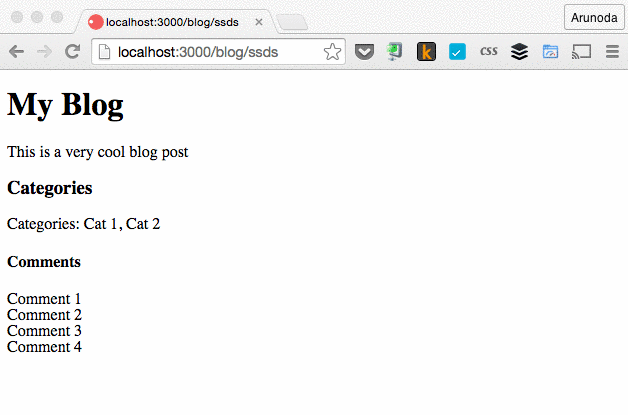TKVERN 翻译 | 源文档链接FlowRouter
(如果你发现翻译中存在谬误的地方, 请留言, 我会继续造福社会. 建议结合源文档查看翻译)
为Meteor精心设计的客户端Router
FlowRouter 是 Meteor 一个非常简单的路由器.它为客户端程序routing,不处理渲染本身.
它为改变URL和获取数据获取提供了一个良好的API. 然而, 在router内部, 这不是reactive. 最重要的是, FlowRouter 的设计时考虑到性能和专注于自己最擅长的: routing.
如果你已经在使用 FlowRouter,我们发布了2.0版本,同时遵循 migration guide.
TOC
- Meteor Routing Guide
- Getting Started
- Routes Definition
- Group Routes
- Rendering and Layout Management
- Triggers
- Not Found Routes
- API
- Subscription Management
- IE9 Support
- Hashbang URLs
- Prefixed paths
- Add-ons
- Difference with Iron Router
- Migrating into 2.0
Meteor Routing Guide
Meteor Routing Guide 是一个关于 Meteor routing 主题的完整指南 . 谈论了如何正确使用 FlowRouter 和 Blaze and React. 也显示了如何管理 subscriptions 和在视图实现 auth logic.
Getting Started
添加 FlowRouter 到你的app:
1 | meteor add kadira:flow-router |
让我们写第一个 route (添加文件到 lib/router.js):
1 | FlowRouter.route('/blog/:postId', { |
在浏览器访问 /blog/my-post-id, 或从console调用下面的命令:
1 | FlowRouter.go('/blog/my-post-id'); |
然后,你就可以在console看到打印的消息了.
Routes Definition
FlowRouter 的 routes 非常简单, Express 和 iron:router都有使用基于path-to-regexp的语法
下面是一个简单的route语法:
1 | FlowRouter.route('/blog/:postId', { |
那么,当你访问这个url的时候,这条route就会被激活:
1 | FlowRouter.go('/blog/my-post?comments=on&color=dark'); |
在你访问这条route之后, console会打印下面内容:
1 | Params: {postId: "my-post"} |
对于单个 interaction, router只会运行一次. 这意味着, 在你访问 route 后, 它会首先调用 triggers, 接着是 subscriptions, 最后调用 action. 出现没有这些方法这种情况后,route访问将会再次调用.
你可以在 client 任何目录定义routes. 但是, 我们推荐你添加到 lib 目录. 那么 fast-render 能够检测 subscriptions 和 send 它们给你 (我们会在这里谈论).
Group Routes
你可以对routes分组来更好的组织route. 这是一个例子:
1 | var adminRoutes = FlowRouter.group({ |
所有对于 FlowRouter.group() 的options都是可选的.
你甚至可以像下面一样嵌套group routes:
1 | var adminRoutes = FlowRouter.group({ |
你可以判断当前的route是在使用哪个group:
1 | FlowRouter.current().route.group.name |
如果当前的route是具体的group (e.g. admin, public, loggedIn) 无需使用前缀,如果你不想.如果它是一个嵌套的group, 你可以像这样获取父级group的name:
1 | FlowRouter.current().route.group.parent.name |
如同所有的当前 route 属性, 都不是 reactive, 但是可以结合FlowRouter.watchPathChange() 获取group名.
Rendering and Layout Management
FlowRouter 不处理渲染和布局管理. 为此, 你可以使用:
这样在一个route你可以从 action 的内部 method调用布局管理.
1 | FlowRouter.route('/blog/:postId', { |
Triggers
Triggers 是 FlowRouter 可以允许你在 enter 这个 route 之前和 exit 这个 route 之后执行相应的任务.
Defining triggers for a route
这里是如何为一个 route 定义 triggers :
1 | FlowRouter.route('/home', { |
Defining triggers for a group route
这里是如何在一个 group 定义里定义 triggers.
1 | var adminRoutes = FlowRouter.group({ |
你可以添加 triggers 到单个 routes 或是 group .
Defining Triggers Globally
你同样可以定义全局 triggers. 这里是怎么做:
1 | FlowRouter.triggers.enter([cb1, cb2]); |
如你所看到的最后两个例子, 你可以筛选 routes 使用 only 或者 except 关键字. 但是, 你不能同时使用 only and except.
如果你想了解更多关于 triggers 和 设计决策, 访问 here.
Redirecting With Triggers
你可以使用 triggers 重定向到一个不同 route . 你可以在triggers enter 和 exit 做到这一点. 看看如何做的吧:
1 | FlowRouter.route('/', { |
每个 trigger callback 的第二个参数: 一个 function 你可以使用 redirect 到 一个不同的 route. Redirect 也有一些属性来确保不会阻止 router.
- redirect 必须是调用一个 URL
- redirect 必须在同一个event循环周期 (没有异步或调用内部 Tracker)
- redirect 不能多次调用
检查这个 PR 以了解更多关于 redirect 的 API.
Stopping the Callback With Triggers
在有些情况, 你也许需要停止使用 triggers 的 route callback. 你可以在 before triggers, 使用第三个参数: stop function. 例如, 你可以检查前缀, 如果失败, 在before action停止和显示 notFound layout.
1 | var localeGroup = FlowRouter.group({ |
Note: 当你使用 stop function,即使你不使用它,你应该通过第二个 redirect 参数.
Not Found Routes
你可以像这样配置 Not Found 的 routes:
1 | FlowRouter.notFound = { |
API
FlowRouter 有丰富的 API 帮助你浏览这个 router 和获取这个 router 的信息.
FlowRouter.getParam(paramName);
你可以使用 Reactive function 获取 URL 的一个参数.
1 | // route def: /apps/:appId |
FlowRouter.getQueryParam(queryStringKey);
你可以用Reactive function 的 queryString 查询你需要的value.
1 | // route def: /apps/:appId |
FlowRouter.path(pathDef, params, queryParams)
从定义的path中生成path. 都有 params 和 queryParams 两个选项.
URL的特殊字符在 params 和 queryParams 中会被转码.
1 | var pathDef = "/blog/:cat/:id"; |
如果没有 params 或 queryParams, 这将只会返回 pathDef.
Using Route name instead of the pathDef
你也可以使用 route’s name 代替 pathDef. 那么, FlowRouter 会从给定的 route 选择 pathDef. 看下面的例子:
1 | FlowRouter.route("/blog/:cat/:id", { |
FlowRouter.go(pathDef, params, queryParams);
这将通过 FlowRouter.path 基于 arguments 和 re-route 到达相应的 path , .
你可以像这样调用 FlowRouter.go :
1 | FlowRouter.go("/blog"); |
FlowRouter.url(pathDef, params, queryParams)
就像 FlowRouter.path, 但给出的是绝对路径. (在后端使用 Meteor.absoluteUrl.)
FlowRouter.setParams(newParams)
这会改变当前的 params, re-route 到新的 path.
1 | // route def: /apps/:appId |
FlowRouter.setQueryParams(newQueryParams)
就像 FlowRouter.setParams, 但是是 queryString params.
删除 query param 设置为 null 如下:
1 | FlowRouter.setQueryParams({paramToRemove: null}); |
FlowRouter.getRouteName()
获取route reactively 的 name.
1 | Tracker.autorun(function() { |
FlowRouter.current()
获取 router 的当前状态. This API is not reactive.
如果你需要观察 path 的变化,可以使用 FlowRouter.watchPathChange().
这给出来一个 object:
1 | // route def: /apps/:appId |
FlowRouter.watchPathChange()
监听 path 的变化.如果你需要像使用 API 一样获得 params 或queryParams 可以用 FlowRouter.getQueryParam().
1 | Tracker.autorun(function() { |
FlowRouter.withReplaceState(fn)
通常, 所有的 route 改变通过像 FlowRouter.go 和 FlowRouter.setParams() 这样的 APIs 添加 URL item 到浏览器的 history. 例如, 运行下面的代码:
1 | FlowRouter.setParams({id: "the-id-1"}); |
现在你可以点击浏览器的后退按钮2次. 这是常见的行为, 因为用户可以点击“后退”按钮, 并期待看到应用程序的前一个状态.
但是有些时候, 这不是你想要的. 你不需要污染浏览器 history. 那么, 你可以使用下面的语法.
1 | FlowRouter.withReplaceState(function() { |
现在, 没有任何 item 在浏览器 history 中了. 就像 FlowRouter.setParams, 你可以使用任何 FlowRouter 的 API 在 FlowRouter.withReplaceState 里面.
我们命名这个功能为
withReplaceState, 因为, replaceState 是 underline API 用于此功能. 阅读更多关于 replace state & the history API.
FlowRouter.reload()
FlowRouter routes 是幂等的. 这意味着, 即使你多次调用 FlowRouter.go() 到相同的 URL , 但是它只在第一次运行时激活. 这也是真实的直接点击路径.
因此, 如果你真的需要 reload 这个 route, 这个就是你想要的 API .
FlowRouter.wait() and FlowRouter.initialize()
在默认情况下, FlowRouter 初始化这个路由 process 在 Meteor.startup() 中回调. 对大多数app而言是这样工作. 但是, 一些 app 自定义初始化需要在 FlowRouter 初始化之后.
因此, FlowRouter.wait() 可以帮助你.你需要直接在 JavaScript 文件里调用. 然后, 当时的 app 准备好后调用 FlowRouter.initialize().
eg:-
1 | // file: app.js |
查看更多信息访问 issue #180.
FlowRouter.onRouteRegister(cb)
这个 API 是特地为开发人员开发插件设计的. 他们可以监听任何 registered route 和为 FlowRouter 添加自定义功能. 这都工作在服务器端和客户端.
1 | FlowRouter.onRouteRegister(function(route) { |
让我们看一个为用户定义的route:
1 | FlowRouter.route('/blog/:post', { |
这个 route 的 object 会这这样:
1 | { |
因此, 这不是我们正在使用的内部 route object.
Subscription Management
对于订阅管理,我们强烈建议你遵循 Template/Component level subscriptions. 在这里查看 guide.
FlowRouter 也有它自己的订阅管理机制. 我们将在 3.0 版本移除. 我们不排除 2.x 版本 因为这是实现你 APP FastRender 支持最简单的方法.在 3.0 版本我们更好的支持 FastRender 在服务端渲染.
FlowRouter 只涉及 registration 和 subscriptions. 它不用等待 subscription 完成. 这是如何注册一个 subscription.
1 | FlowRouter.route('/blog/:postId', { |
我们也可以像这样全局注册 subscriptions :
1 | FlowRouter.subscriptions = function() { |
所有的全局 subscriptions 都运行在每一个 route 上. 因此, 在注册订阅是要特别注意命名.
然后你可以注册你的 subscriptions, 完成之后你可以检查 subscriptions 的状态:
1 | Tracker.autorun(function() { |
因此, 你可以使用 FlowRouter.subsReady 在 template helpers 内部显示加载状态和相应的行为.
FlowRouter.subsReady() with a callback
有些时候, 我们需要使用 FlowRouter.subsReady() 在 autorun 中是不可用的. 这有一个事件处理的例子. 在这样的地方, 我们可以使用回调 API FlowRouter.subsReady().
1 | Template.myTemplate.events({ |
Arunoda 有讨论更多关于订阅管理 FlowRouter, 在个博客里 this 这篇文章 FlowRouter and Subscription Management.
他展示了如何构建一个app:
Fast Render
FlowRouter 支持 Fast Render.
meteor add meteorhacks:fast-render- 把
router.js放在共享目录. 我们建议lib/router.js.
你可以排除 Fast Render 支持通过包装 subscription registration 在 isClient 块:
1 | FlowRouter.route('/blog/:postId', { |
Subscription Caching
你也可以使用 Subs Manager 在客户端缓存 subscriptions . 我们没有有任何特别的事情来让它工作. 它应该像其他 routers 一样工作.
IE9 Support
FlowRouter 支持 IE9. 但是它没有 HTML5 history polyfill. 因为大多数app不需要它.
如果你需要支持 IE9, 添加 HTML5 history polyfill 到你的packege.
1 | meteor add tomwasd:history-polyfill |
Hashbang URLs
使用网址名 mydomain.com/#!/mypath 简单设置 hashbang 为 true在初始化的 function 中:
1 | // file: app.js |
Prefixed paths
例如,你希望在同一域名下运行多个web应用程序, 你可能会想在子路径在运行特定的 meteor application 服务 (eg example.com/myapp). 在这种情况下只包括路径前缀在 meteor ROOT_URL 的环境变量, FlowRouter 将会透明的处理没有任何额外参数的配置.
Add-ons
Router 是基于 package 的 app. 其他项目像 useraccounts 需要 FlowRouter 支持. 否则, FlowRouter 很难用在真实项目中. 先在有很多 packages 都有 started to support FlowRouter.
因此, 你可以使用你喜欢的 FlowRouter package. 如果不是, 有一个叫 easy process 的包可以将它们转换为 FlowRouter.
Add-on API
我们还发布了一个 new API 去支持开发者开发插件. 当用户在应用程序中创建一个路由时, 可以得到一个通知.
如果你有更多关于插件 API 的想法, 查看 let us know.
Difference with Iron Router
FlowRouter 和 Iron Router 是两个不同的 routers. Iron Router 试图成为一个全功能的解决方案.它试图做每一件事包括 routing, subscriptions, rendering and layout management.
FlowRouter 是一个简单的解决方案在 routing , UI performance 上. 它公开了有关功能的 APIs.
让我们了解更多的差别:
Rendering
FlowRouter 不处理渲染. 通过解耦渲染, 它可以使用任何渲染框架, 比如使用 Blaze Layout 进行动态模版渲染 .在路由动作中, 可以调用像 React 这样的布局框架.
Subscriptions
对于 FlowRouter, 我们强烈建议你使用 template/component layer subscriptions. 但是,如果你需要在路由器层做路由, FlowRouter 有 subscription registration 机制. 即使有, FlowRouter 永远不要等待 subscriptions 和 view layer 来做.
Reactive Content
在 Iron Router 你可以在 reactive content 里面使用 router, 但是任何一个 hook 或 method 可以以一个不可预测的方式重新运行. FlowRouter 限制; reactive 的数据源单个的运行; 当首先调用的时候.
我们认为这是可行当方法. Router 只是用户当 action. 我们可以在渲染层完成响应内容的工作.
router.current() is evil
Router.current() 是邪恶的. 为什么? 让我们看看下面的这个例子.想象一下我们的 app 有这样一个 route:
1 | /apps/:appId/:section |
现在让我们说,我们需要从 URL 获取 appId. 我们会这样做, 像在 Iron Router 一样.
1 | Templates['foo'].helpers({ |
我们在 route 中改变 :section . 那么上面的方法也会重新运行. 如果我们增加一个 query param 到 URL, 它也会重新运行. 这是因为 Router.current() 会寻找改变 route(or URL). 但是在任何情况下, appId 不会改变.
因为这个, 我们到应用程序很多部分会重新运行,重新渲染. 这将会出现不可预测到渲染行为.
FlowRouter 为修复次问题提供里 Router.getParam() API. 看看如何使用:
1 | Templates['foo'].helpers({ |
No data context
FlowRouter 没有 data context. Data context 会有像 .current() 这样到问题. 我们相信, 它可以直接在 template (component) 层获取数据.
Built in Fast Render Support
FlowRouter 已构建 Fast Render 支持. 只要天骄 Fast Render 到你到 app 它就会工作里. router 不需要做任何改变.
更多关于 check 信息的文档, 查看 docs.
Server Side Routing
FlowRouter 是客户端 router 它不支持服务的路由. 但是 subscriptions 运行在服务的支持 Fast Render.
Reason behind that
Meteor 不是一个从服务器直接发送 HTML 到客户端的传统开发框架. Meteor 最初需要发送一个特殊的 HTML 到客户端. 因此, 你不能直接向客户端发送一些东西.
此外, 相比于客户端, 在服务器端我们需要寻找一些不同的东西. 例如:
- 在服务器端我们必须处理头文件.
- 在服务器端我们必须处理像
GET,POST这样类似的方法. - 还有 Cookies.
因此, 最好使用服务器端专用的 router 像 meteorhacks:picker. 它支持连接和表达中间件, 并且它的 route 语法很简单.
Server Side Rendering
FlowRouter 3.0 将有服务器端渲染的支持. 我们已经开始了初步版本, 查看这个branch ssr.
这目前是非常有用的, Kadira 的 https://kadira.io 已经有在使用.
Better Initial Loading Support
在 Meteor 中, 我们要等到渲染之前发送所有到JS和其他资源. 这是一个问题. 在 3.0 版本, 在服务器端的支持下我们修复了它.
Migrating into 2.0
迁移到 2.0 版本是很容易到, 你不需要改变应用到任何代码,因为你已经在使用 2.0 版本的 APIs 了. 在 2.0 版本, 我们改变了名字和删除了一些过时的 APIs.
以下是将应用迁移到 2.0 版本的步骤.
Use the New FlowRouter Package
- Now FlowRouter comes as
kadira:flow-router - So, remove
meteorhacks:flow-routerwith :meteor remove meteorhacks:flow-router - Then, add
kadira:flow-routerwithmeteor add kadira:flow-router
Change FlowLayout into BlazeLayout
- 我们重新命名了 FlowLayout 为 BlazeLayout.
- 因此, 移除
meteorhacks:flow-layout和添加kadira:blaze-layout即可. - 你需要使用
BlazeLayout.render()代替FlowLayout.render()
Stop using deprecated Apis
- 这没有中间件支持. 使用 triggers 代替.
- 这没有 API 叫
.reactiveCurrent(), 使用.watchPathChange()代替. - 早些时候,你可以用
FlowRouter.current().params.query访问和查询params. 但是, 现在你不能这样总了. 使用FlowRouter.current().queryParams代替.





